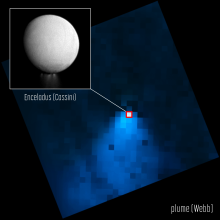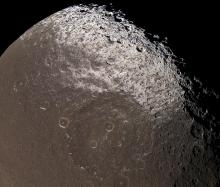Listen to today's episode of StarDate on the web the same day it airs in high-quality streaming audio without any extra ads or announcements. Choose a $8 one-month pass, or listen every day for a year for just $30.
You are here
Moon and Saturn
When lightning strikes on the planet Saturn, it can be a real blast. A single bolt can be 10,000 times more powerful than one on Earth.
The Cassini spacecraft orbited Saturn for 13 years. During that time, its instruments recorded radio waves from many lightning strikes. But they weren’t spread out, as lightning is here on Earth. Instead, they came from three main regions — but not at the same time.
The first group crackled through lightning alley — a narrow band in the southern hemisphere. Storms there occasionally produced lightning from 2004 until late 2010 — a few flashes per minute.
By then, a giant storm had roared to life in the northern hemisphere. Known as the Great White Storm, it was thousands of miles wide and tens of thousands of miles long. And it produced the most intense lightning that Cassini ever recorded — tens of blasts per second.
As that storm faded away, a smaller one took over — a white circle a couple of thousand miles in diameter. It produced periodic outbursts from late 2011 through 2013. After that, Cassini didn’t hear any lightning at all for the final four years of its mission.
Scientists are trying to understand why the lightning was concentrated in small areas — and why it disappeared.
Look for Saturn to the upper right of the Moon as night falls. It looks like a bright star. The brighter planet Jupiter is to the right of Saturn.
Script by Damond Benningfield





